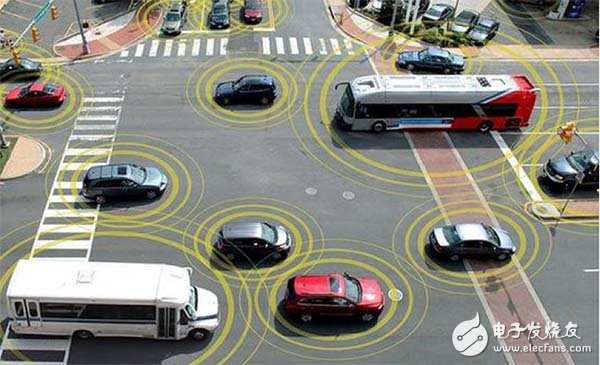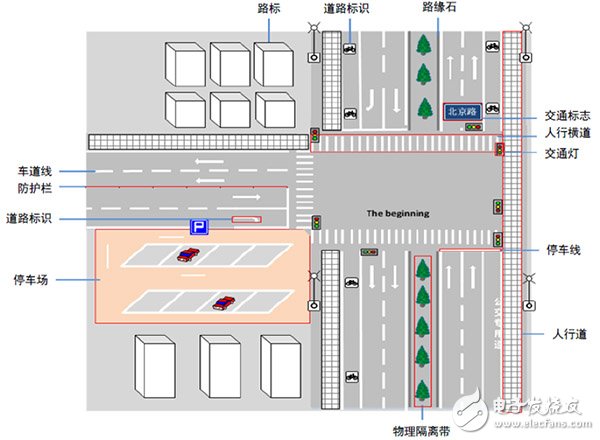The era of V2X has arrived, how can traditional car companies avoid being out?
It can be said that the era of V2X has arrived. X is known and unknown. Known X includes P (People: People), I (Infrastructure), R (Road), V (Vehicle). The unknown A (all things: Anything) is in the rapid development design.
But there is a problem, that is, there are so many V2X materials on the network today, as an engineer needs to talk about V2X from that aspect? As for the disputes in the network, whether it is DSRC or LTE-V, I think these are reasonable, but some are out of the user, and users don't care about the way they connect. The author believes that the way of interconnecting things does not have to be fixed. Through the camera, the sensor can obtain information as a kind of interconnection. The author will explore the X is the easiest to achieve according to the user's needs, that X is the basis for automatic driving, and that X is closely related to the life of ordinary users.
V2V
Let's talk about V2V (Vehicle to Vehicle) which is easy to implement first. Why is V2V the easiest to implement? This may not be a very accurate description, as this V2V achievability is relative to the same brand. V2V is implemented in all brands of vehicles in a country, and may require uniform standards at the national level. It is not described here.
Speaking of V2V, the most common application scenario is that in urban streets and highways, vehicles can communicate with each other, send data, and share information. Such data includes: the speed of the vehicle, the relative position, the brakes, the straight or the left turn, etc. All the data relating to driving safety are provided to the surrounding vehicles in advance, which enables the surrounding vehicles to predict the driving behavior of the other vehicles, thereby Achieve active safety strategies to improve driving safety and provide data support for semi-automatic driving and automatic driving.

The above picture is a very vivid description of the principle of V2V. The simplest example is the trucks produced by the Mercedes Actros series, all equipped with road pilot connection software developed by Mercedes-Benz. During the driving process, 3 trucks are automatically arranged in a row by V2V technology. The first truck collects road data and its own control data and transmits it to the next two trucks via WIFI in 0.1s. This enables driving synchronization, acceleration and braking, straight and steering. Therefore, the latter two vehicles can achieve vehicle following without a driver, saving a lot of cost. Of course, the future of V2V certainly can not only achieve such a simple function, but this is the original prototype of V2V.
V2V vehicles are not only easy to implement, but also improve driving safety and operational efficiency. This is the three fulcrums that V2V is the easiest to implement:
Achievability: Just add a T module or V module to the same brand vehicle and provide software algorithms.
Safety: V2V technology can be used as an ADAS function module to reduce the accident rate of vehicles;
Operational profitability: V2V brings another operation and maintenance mode to the OEM, which is to freely and effectively build intelligent fleets, plan routes, reduce fuel consumption and improve operating income.
The author believes that DSRC's proprietary radio frequency (75MHz spectrum in the 5.9GHz band, the United States Federal Communications Commission (FCC) specifically allocated for Intelligent Transportation Systems (ITS) in 1999) is very suitable for V2V.
V2R
The next thing to say is V2R (Vechile to Road). Many people want to classify V2R as part of V2I, but I believe that V2R should be divided separately by demand and achievability, as a key part of the faster implementation of semi-automatic driving and autonomous driving, to achieve V2R as soon as possible.
V2R needs to be divided into two scenarios, the first is the highway and the second is the urban road. The expressway is the first step, and the urban road needs to be based on the identification of the increased identification in the urban road to achieve more complex data judgment and data communication.
V2R on a highway is relatively easy. The first is the clear identification, no sidewalks, traffic lights, pedestrians and other complex road conditions, only need to identify the highway and vehicle driving and highway entrance and exit signs. Secondly, the high-precision map has already laid out the highway in advance. The high-precision map can be accurate to the centimeter level, which is very helpful for the route planning and automatic driving of the vehicle. With the support of high-precision maps, the interaction of V2R will be relatively small and it will be more convenient to handle. Finally, the realization of V2V as soon as possible can also help the rapid development of V2R. Because each car can share the collected road information and pass this information to the cloud to promote the rationalization and perfection of road information.
For urban roads, more information needs to be processed, which requires more information collected by the vehicle, more processing power, and is associated with both V2I and V2P, which is the most realized realization of automatic driving. Difficult obstacles. Perhaps a proprietary transportation route or public transportation is the main way for future human travel, and it is worth exploring and in-depth research.

V2R is now developed through millimeter-wave radar and cameras. It supports high-precision maps and cloud support. As long as V2V is realized, semi-automatic driving and automatic driving are not far away on the highway.
V2I
Then let the author lead everyone to understand V2I. As mentioned in the opening paragraph, I does not refer to the telecommunication infrastructure, but refers to all the infrastructure encountered during the driving of the vehicle. This includes traffic lights, bus stops, utility poles, buildings, overpasses, tunnels and much more. The V2I communication function will specifically adopt the 760MHz frequency band of the in-vehicle intelligent transportation system. Using this frequency band, the basic communication between the basic implementation and the vehicle can be realized without affecting the on-board sensor, thereby obtaining the necessary key information. When the visibility at the intersection is poor, the V2I communication system can receive the traffic light information, and receive the information of the vehicle and pedestrians through the V2V and V2P systems, and submit it to the vehicle brain (AB) system, and the vehicle brain passes the vehicle operating system. (AOS) Analytical processing, controlling whether the car continues to drive or continues to wait.

In 2014, the Manhattan and Brooklyn districts of New York City have taken the lead in piloting, traffic lights have been equipped with V2I hardware, and more than 10,000 urban vehicles have been equipped with V2V equipment. In addition, in the statement, the US Department of Transportation will invest 17 million US dollars to Tampa, with V2V technology to minimize the peak traffic congestion.
Collaborative environment-aware system, the author believes that in addition to the 760MHz communication band of the vehicle intelligent transportation system, LTE-V (based on LTER14 technology (4G/5G), including LTE-VD and LTE-V-Cell, is in the standard The LTE-VD in the key phase of development is also an effective tool for implementing V2I. Because all I (infrastructure) does not need to be moved, an I module is used to achieve short-distance communication, which can be received by the vehicle. The vehicle can be effectively operated with the current communication 4G/5G and satellite positioning BDS/GPS technology.
V2P
Finally, let the author scratch his head, "the white-headed scorpion is shorter", because V2P is a technology that is closely related to everyone, and it is not only a technical problem, but also rises to the state, society, privacy, moral level, and thus becomes Very difficult to achieve. The information found in the network was also brought in by clever and random.
In fact, V2P is not as complicated as it might seem. After all, the era of a mobile phone is now coming. Whether it is a mobile phone, especially a wearable device, you can guestly interact with the P module mentioned in this article to achieve interactive communication with the V module in the vehicle.
So what should the P module use? The author believes that LTE-V-Cell in LTE-V is an effective tool for implementing V2I, because all P (active people, people only have activities to make sense) are required to move at any time, equipped with a module that can be interconnected at any time. Only then can the vehicle be received at any time. The vehicle can be effectively complemented by a camera, radar sensor and other identification technologies to effectively implement V2P.
In short, for the traditional car companies, V2X can not eat a fat man, but step by step every step. First plan the internal V2V (in-vehicle configuration V module and standard protocol), and then take it to all the OEMs; then implement V2R on the highway (in-vehicle configuration camera, radar sensor and high-precision map); Down with the country, the infrastructure will be transformed to realize V2I (I module for installation of V module communication in the infrastructure and in-vehicle configuration); finally, the whole people realize the importance of self-protection and self-identification, just like a mobile phone for everyone. In the same way, V2P is completed (each person wears a P module that communicates with the V module and the I module), and the whole person can connect. In that way, the realization of V2A (Anything), semi-automatic driving and automatic driving will be completed.
KNBL1-32 Residual Current Circuit Breaker With Over Load Protection
KNBL1-32 TWO FUNCTION : MCB AND RCCB FUNCTIONS
leakage breaker is suitable for the leakage protection of the line of AC 50/60Hz, rated voltage single phase 240V, rated current up to 63A. When there is human electricity shock or if the leakage current of the line exceeds the prescribed value, it will automatically cut off the power within 0.1s to protect human safety and prevent the accident due to the current leakage.
leakage breaker can protect against overload and short-circuit. It can be used to protect the line from being overloaded and short-circuited as wellas infrequent changeover of the line in normal situation. It complies with standard of IEC/EN61009-1 and GB16917.1.
KNBL1-32 Residual Current Circuit Breaker,Residual Current Circuit Breaker with Over Load Protection 1p,Residual Current Circuit Breaker with Over Load Protection 2p
Wenzhou Korlen Electric Appliances Co., Ltd. , https://www.zjmannualmotorstarter.com